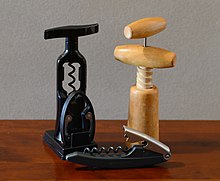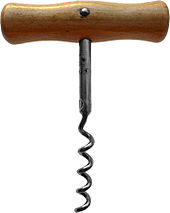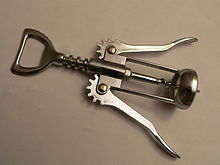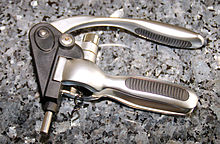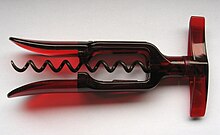
A fruit press is a device used to separate fruit solids—stems, skins, seeds, pulp, leaves, and detritus—from fruit juice.

Cork is an impermeable buoyant material. It is the phellem layer of bark tissue which is harvested for commercial use primarily from Quercus suber, which is native to southwest Europe and northwest Africa. Cork is composed of suberin, a hydrophobic substance. Because of its impermeable, buoyant, elastic, and fire retardant properties, it is used in a variety of products, the most common of which is wine stoppers.
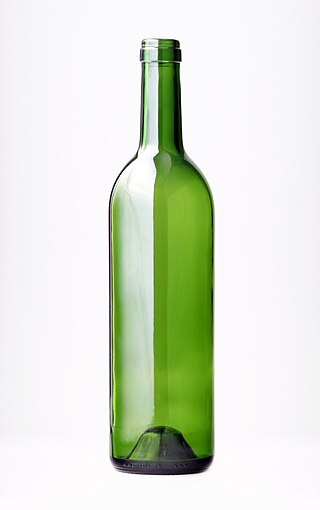
A bottle is a narrow-necked container made of an impermeable material in various shapes and sizes that stores and transports liquids. Its mouth, at the bottling line, can be sealed with an internal stopper, an external bottle cap, a closure, or induction sealing.

A bottle cap or bottle top is a closure for the top opening of a bottle. A cap is sometimes colorfully decorated with the logo of the brand of contents. Plastic caps are used for plastic bottles, while metal with plastic backing is used for glass; plastic caps are commonly made from polyethylene or polypropylene, while metal caps are usually either steel or aluminum. Plastic caps may have a pour spout. Flip-Top caps like Flapper closures provide controlled dispensing of dry products. Caps for plastic bottles are often made of a different type of plastic from the bottle.
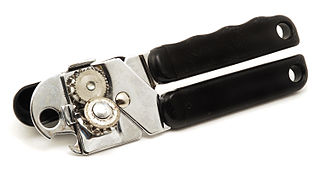
A can opener or tin opener is a mechanical device used to open metal tin cans. Although preservation of food using tin cans had been practiced since at least 1772 in the Netherlands, the first can openers were not patented until 1855 in England and 1858 in the United States. These early openers were basically variations of a knife, though the 1855 design continues to be produced.

A stopper, bung, or cork is a cylindrical or conical closure used to seal a container, such as a bottle, tube, or barrel.

A bottle opener is a device that enables the removal of metal bottle caps from glass bottles. More generally, it might be thought to include corkscrews used to remove cork or plastic stoppers from wine bottles.

A closure is a device used to close or seal a container such as a bottle, jug, jar, tube, or can. A closure may be a cap, cover, lid, plug, liner, or the like. The part of the container to which the closure is applied is called the finish.

A wire stripper is a small, hand-held device used to strip the electrical insulation from electric wires.
Wine accessories are things that may be used in the storage or serving of wine. Wine accessories include many items such as wine glasses, corkscrews, and wine racks.

A balance spring, or hairspring, is a spring attached to the balance wheel in mechanical timepieces. It causes the balance wheel to oscillate with a resonant frequency when the timepiece is running, which controls the speed at which the wheels of the timepiece turn, thus the rate of movement of the hands. A regulator lever is often fitted, which can be used to alter the free length of the spring and thereby adjust the rate of the timepiece.

A picket line is a horizontal rope along which horses are tied at intervals. The rope can be on the ground, at chest height or overhead. The overhead form is usually called a high line.

Wine corks are a stopper used to seal wine bottles. They are typically made from cork, though synthetic materials can be used. Common alternative wine closures include screw caps and glass stoppers. 68 percent of all cork is produced for wine bottle stoppers.

Alternative wine closures are substitute closures used in the wine industry for sealing wine bottles in place of traditional cork closures. The emergence of these alternatives has grown in response to quality control efforts by winemakers to protect against "cork taint" caused by the presence of the chemical trichloroanisole (TCA).

Closure is a term used in the wine industry to refer to a stopper, the object used to seal a bottle and avoid harmful contact between the wine and oxygen.
A beverage opener is a device used to open beverage cans, plastic bottles or glass bottles, which are the three most common beverage containers.
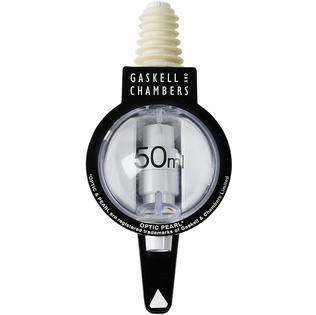
Alcoholic spirits measures are instruments designed to measure exact amounts or shots of alcoholic spirits.

A flip-top, swing-top, lightning toggle, or Quillfeldt stopper is a type of bail closure frequently used for bottles containing carbonated beverages, such as beer or mineral water. The mouth of the bottle is sealed by a stopper, usually made of porcelain or plastic, fitted with a rubber gasket and held in place by a permanently attached wire bail. The bottle can be opened and resealed repeatedly without the use of a bottle opener, with the wires acting in the same way as a latch clamp. The flip-top was the dominant method of sealing beer and mineral water bottles prior to the invention of the crown cork

A mounted or bar corkscrew is a device screwed or clamped to a wall or counter top, used to draw corks from beer, wine or other bottles.
Samuel Henshall was an English clergyman and writer, and inventor of a type of corkscrew.
